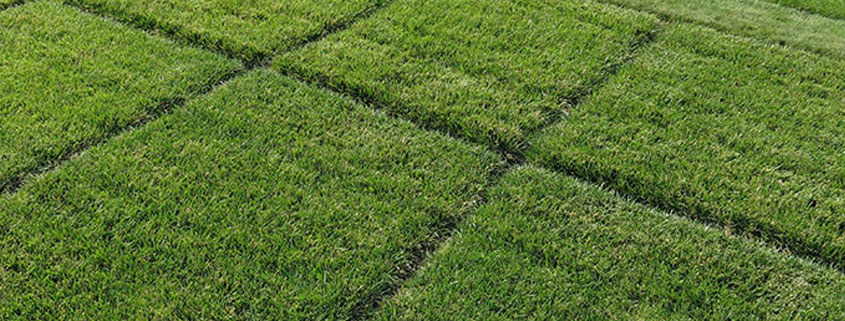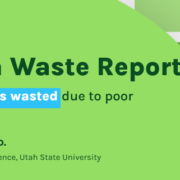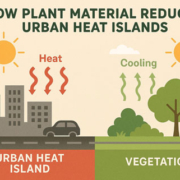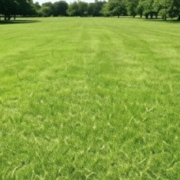How to Maintain Sustainable Turfgrass
Turfgrass is often criticized in water conservation conversations. I’ve seen it everywhere from media headlines to municipal rebate programs and the message is clear. If you want to save water, rip out your lawn. But is grass really the villain it’s made out to be? Spoiler alert…..it’s not. In fact, when managed properly, your lawn can look good while providing environmental benefits. And these are benefits that go far beyond curb appeal.
Well-maintained lawns help cool the air through evapotranspiration, reduce soil erosion, filter stormwater, and sequester carbon. And with the new drought-tolerant grass varieties we have available today, smarter irrigation technologies, and proper management practices, you can significantly reduce irrigation to your lawn while maintaining a healthy green space that supports both you and the environment.
Research Highlights
- Choosing the right grass for your location is one of the most important decisions you can make when aiming for a sustainable, water-wise lawn.
- Watering deeply and infrequently is one of the best things you can do for your lawn.
- Mow high: about 3 inches for most cool season grasses and slightly lower for warm season grasses.
- Apply slow-release or organic fertilizers that feed the lawn gradually over time.
Today, I’m sharing practical, research-based tips for maintaining turfgrass in a sustainable way at home. From selecting the right grass species and varieties to optimizing your irrigation system efficiency, there are lots of ways to make your lawn a “smart” user of water—without sacrificing the functional and recreational value it provides.
Why Keep Your Turf?
Despite the turf removal campaigns out there, there are compelling reasons to keep your lawn, especially when it’s maintained in a sustainable and water-efficient way. Turfgrass provides a host of ecosystem services that benefit both people and the environment. One of the most important is cooling the atmosphere through evapotranspiration—a process where water evaporates from the soil and transpires through plant leaves, reducing air temperatures in the surrounding areas. We know that turf-covered surfaces can be significantly cooler than adjacent hardscapes like asphalt or concrete (Shashua-Bar et al., 2009), and this helps reduce heat in urban and suburban areas, reducing the need for air conditioning of structures.
Turfgrass also sequesters carbon by capturing carbon dioxide from the atmosphere and storing it in plant tissues and associated soil organic matter. In fact, researchers have found that found that well-managed lawns can sequester up to one metric ton of carbon per hectare per year, making grasses valuable tools in the fight against climate change (Qian et al., 2010). Grasses also prevent soil erosion, stabilize ground surfaces, and slow stormwater to allow infiltration, helping to reduce runoff and protect water quality.
Beyond its environmental benefits, grasses also have important social and functional roles. Grassy areas provide safe, open spaces for children to play, pets to roam, and communities to gather. A healthy lawn also contributes to a home’s aesthetic appeal and property value, offering a visual softness that complements the built environment in which we live. Really, it’s a multifunctional green surface that, when managed responsibly, can be part of a sustainable urban landscape—not a barrier to it. Rather than eliminating turf outright, the focus should be on using the right grass, in the right place, with the right management practices.
The ”Right” Grass
Choosing the right grass for your location is one of the most important decisions you can make when aiming for a sustainable, water-wise lawn. Turfgrasses fall into two broad categories: cool-season grasses (like Kentucky bluegrass and tall fescue), which thrive in northern and transition climates, and warm-season grasses (like bermudagrass, zoysiagrass, and buffalograss), which are better suited to warm regions. Matching the grass species to your local temperatures, rainfall, and growing season will improve its performance and reduce the need for supplemental irrigation and fertilizer.
Today, thanks to advances in plant breeding, we also have access to low-input, drought-tolerant grass cultivars that maintain great color and density with much less water. New varieties of several different grasses, for example, have been shown to use 30–60% less water than standard varieties while remaining green and resilient under drought stress.
These days turfgrass breeding programs focus on drought tolerance, pest resistance, and slower growth (to reduce mowing frequency). Generally speaking, it’s all about less maintenance. Selecting the right grass variety for your location allows you to maintain a healthy, green lawn that supports sustainability without sacrificing aesthetics or function. It’s not just about having a lawn—it’s about having the right lawn for your environment.
Get Smart About Irrigation
One thing that can make or break a sustainable lawn is how you water it. Smart irrigation isn’t just about using less water—it’s about using it correctly. Watering deeply and infrequently, for example, is one of the best things you can do for your lawn. This encourages grass roots to grow deeper into the soil, making your lawn more resilient during hot and dry spells. Shallow, frequent watering, on the other hand, leads to shallow roots that can’t access moisture deeper in the soil.
Technology can also be a big help here. Smart irrigation controllers (like those certified by the EPA WaterSense™ program) adjust irrigation based on local weather conditions (EPA WaterSense, 2024). These adjustments certainly save water, and they also keep your lawn healthy and happy. Pair a smart controller with pressure-regulating sprinkler heads and/or multi-stream, multi-trajectory sprinkler nozzles, and you’re looking at a system that waters much more evenly and efficiently (Solomon et al., 2006).
Don’t forget the basics, either. A small leak, tilted, or sunken sprinkler heads might not seem like a big deal, but over time, they can waste thousands of gallons of water. Regular walk-throughs of your yard (while the sprinklers are running) to check for leaks, breaks, and problems can make a huge difference. And keeping your irrigation system in good working order doesn’t just conserve water—it improves turf health, reduces disease pressure, and can even lower your water bill.
Get Into a Mowing and Fertilizing Routine
Mowing and fertilizing might seem like basic lawn care tasks that aren’t that important, but when done thoughtfully, they play a huge role in keeping your turfgrass healthy and sustainable. Let’s start with mowing. One of the easiest things you can do to improve your lawn’s water efficiency is to mow high—ideally, around 3 inches for most cool-season grasses and slightly lower for warm-season types. Taller grass blades mean deeper grass roots, better drought tolerance, and more shade on the soil surface, which helps reduce evaporation and discourages weed growth (Goatley et al., 2024). You should also avoid cutting more than one-third of the blade length at one time because mowing too short, too quickly stresses the plant and makes it more vulnerable to heat, pests, and disease pressure (Liu and Huang, 2002).
And while you’re at it, don’t bag the clippings. Leaving the clippings on the lawn, sometimes called grasscyling, returns valuable nutrients (especially nitrogen) to the soil and reduces the need for supplemental fertilizer. It also adds organic matter to the soil, which helps to increase both nutrient and water holding capacity. When you do fertilize, skip the quick-release products and go for slow-release or organic fertilizers that feed the lawn gradually over time. Even better, get a soil test through your state’s Cooperative Extension service. A soil test will tell you exactly what type of fertilizer your lawn requires, so you can avoid applying nutrients you don’t need.
Together, smart mowing and fertilizing practices can significantly reduce your lawn’s environmental impact while improving its health and appearance. Managing turf with intention—not intensity—is key to maintaining its sustainability and environmental benefits.
Get to Know Your Lawn
Keeping your lawn sustainable doesn’t stop after installation—it takes ongoing care and a little know-how. One of the most important things you can do is stay informed and proactive. Start with regular irrigation system audits—check for leaks, broken or misaligned sprinkler heads, and irrigation schedules that waste water. According to the EPA WaterSense program (2023), as much as 50% of outdoor water use may be lost to inefficient irrigation, so small fixes can lead to big savings.
It also pays to learn about your specific grass species and your local climate conditions. Different grasses have different watering, mowing, and fertilization requirements. Warm-season grasses like bermudagrass and buffalograss, for example, are generally more drought-tolerant than cool-season grasses, but we now have low water use cool-season grasses available as well.
For region-specific guidance, your best bet is your local Cooperative Extension Service. These university-based programs offer advice, soil testing, publications, and even in-person training to help you make informed decisions. Many cities and water districts also offer rebate programs for efficient irrigation equipment—just make sure the alternatives you choose still support landscape functionality and environmental health.
Staying on top of maintenance and education ensures that your sustainable lawn keeps looking great—and keeps conserving resources—for years to come.
Conclusion
Sustainable turfgrass isn’t just possible—it’s practical. With the right combination of smart irrigation practices, regionally appropriate grass varieties, thoughtful mowing and fertilization, and regular maintenance, you can enjoy the benefits of a healthy lawn without wasting water or harming the environment. Turfgrasses, when managed wisely, provide valuable ecosystem services, contribute to urban cooling, and offer safe, usable spaces for recreation and gathering.
With care and intention, your lawn can go from being seen as a water waster to becoming a valuable part of the sustainability solution—supporting healthy communities, cooler neighborhoods, and more resilient landscapes. Our greenest future can still include green grass.
References
EPA WaterSense. 2024. WaterSense Labeled Controllers. U.S. Environmental Protection Agency. Retrieved 4/19/25. https://www.epa.gov/watersense/watersense-labeled-controllers.
Goatley, M., M. Aveni, D. Chalmers and R. Nunnally. 2024. Summer lawn management: Watering the lawn. Virginia Cooperative Extension Publication 430-010. Virginia Polytechnic Institute and State University.
Liu, X. and B. Huang. 2002. Mowing effects on root production, growth, and mortality of creeping bentgrass. Crop Science 42(4):1241-1250.
Qian, Y., R.F. Follett and J.M. Kimble. 2010. Soil Organic Carbon Input from Urban Turfgrasses. Soil Science Society of America Journal 74:366–371.
Shashua-Bar, L., D. Pearlmutter and E. Erell. 2009. The cooling efficiency of urban landscape strategies. Landscape and Urban Planning 92:179-186.
Solomon, K.H., J.A. Kissinger, G.P. Farrens and J.E. Borneman. 2006. Performance and water conservation potential of multi-stream, multi-trajectory rotating sprinklers for landscape irrigation. Applied Engineering in Agriculture 23(2):153-163.


















